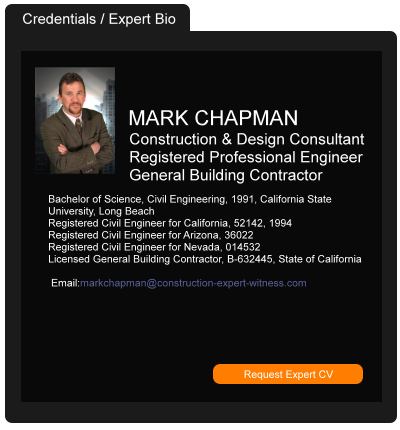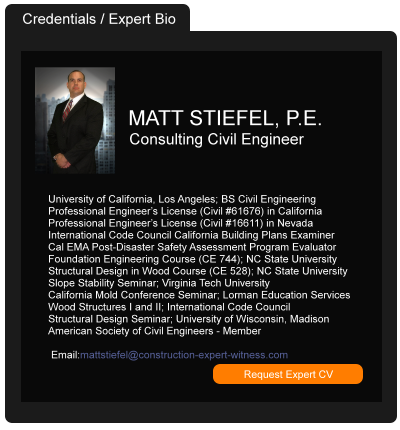Texas Condo Construction Defect Code Amended
September 17, 2015 —
Beverley BevenFlorez-CDJ STAFFAccording to David H. Fisk of Kane Russell Coleman & Logan PC, “Before filing a lawsuit or initiating an arbitration proceeding pertaining to a construction defect, a condominium association in Texas with eight or more units must now comply with the newly added Section 82.119 to Chapter 82 of the Texas Property Code.”
Fisk reported that the new section “requires affected associations to have a licensed professional engineer inspect the units and common elements in question and prepare a written report that (1) identifies the specific units or common elements, (2) describes the present physical condition of the units or common elements, and (3) describes any modifications, maintenance, or repairs to the units or common elements performed by the unit owners or the association.”
Read the court decisionRead the full story...Reprinted courtesy of
Insurer’s Discovery Requests Ruled to be Overbroad in Construction Defect Suit
October 28, 2011 —
CDJ STAFFThe US District Court has ruled in the case of D.R. Horton Los Angeles Holding Co. Inc. v. American Safety Indemnity, Co. D.R. Horton was involved in a real estate development project. Its subcontractor, Ebensteiner Co., was insured by ASIC and named D.R. Horton as an additional insured and third-party beneficiary. D.R. Horton, in response to legal complaints and cross-complaints, filed for coverage from ASIC under the Ebensteiner policy. This was refused by ASIC. ASIC claimed that “there is no potential coverage for Ebensteiner as a Named Insurer and/or D.R. Horton as an Additional Insured.” They stated that “the requirements for coverage are not satisfied.”
The case same to trial with the deadline for discovery set at March 1, 2011. ASIC stated they were seeking the developer’s “job file” for the Canyon Gate project. D.R. Horton claimed that ASIC’s discovery request was overbroad and that it would be “unduly burdensome for it to produce all documents responsive to the overbroad requests.”
D.R. Horton did agree to produce several categories of documents, which included:
“(1) final building inspection sign-offs for the homes that are the subject of the underlying litigation;(2) an updated homeowner matrix for the underlying actions; (3) the concrete subcontractor files; (4) the daily field logs for D.R. Horton’s on-site employee during Ebensteiner’s work; (5) documents relating to concrete work, including documents for concrete suppliers; (6) documents relating to compacting testing; (7) documents relating to grading; and (8) D.R. Horton’s request for proposal for grading”
The court found that the requests from ASIC were overbroad, noting that the language of the ASIC Request for Production of Documents (RFP) 3-5 would include “subcontractor files for plumbing, electric, flooring, etc. - none of these being at issue in the case.” The court denied the ASIC’s motion to compel further documents.
The court also found fault with ASIC’s RFPs 6 and 7. Here, D.R. Horton claimed the language was written so broadly it would require the production of sales information and, again, subcontractors not relevant to the case.
Further, the court found that RFPs 8, 10, 11, and 13 were also overbroad. RFP 8 covered all subcontractors. D.R. Horton replied that they had earlier complied with the documents covered in RFPs 10 and 11. The court concurred. RFP 13 was denied as it went beyond the scope of admissible evidence, even including attorney-client communication.
The court denied all of ASIC’s attempts to compel further discovery.
Read the court’s decision…
Read the court decisionRead the full story...Reprinted courtesy of
Rhode Island Examines a Property Owner’s Intended Beneficiary Status and the Economic Loss Doctrine in the Context of a Construction Contract
March 18, 2019 —
Shannon M. Warren - The Subrogation StrategistIn Hexagon Holdings Inc. v. Carlisle Syntec, Inc. No. 2017-175-Appeal, 2019 R.I. Lexis 14 (January 17, 2019), the Supreme Court of Rhode Island, discussing claims associated with allegedly defective construction, addressed issues involving intended beneficiaries to contracts and the application of the economic loss doctrine. The court held that, based on the evidence presented, the building owner, Hexagon Holdings, Inc. (Hexagon) was not an intended third-party beneficiary of the subcontract between the general contractor (A/Z Corporation) and the subcontractor, defendant McKenna Roofing and Construction, Inc. (McKenna). In addition, the court held that, in the context of this commercial construction contract, the economic loss doctrine applied and barred Hexagon’s negligence claims against McKenna.
Approximately nine years after Hexagon entered into a contract with A/Z Corporation for the construction of a building, Hexagon filed suit against A/Z Corporation’s roofing installation subcontractor, McKenna, and the manufacturer of the roofing system. Hexagon alleged that the roof began to leak shortly after McKenna installed it. Notably, Hexagon did not sue A/Z Corporation.
Read the court decisionRead the full story...Reprinted courtesy of
Shannon M. Warren, White and WilliamsMs. Warren may be contacted at
warrens@whiteandwilliams.com
Location, Location, Location—Even in Construction Liens
October 28, 2015 —
Craig Martin – Construction Contractor AdvisorWe all know the importance of filing a construction lien within 120 days of your last work. Nebraska Construction Lien Act, § 52-137. But, equally, if not more important is filing the construction lien on the correct property.
Often times on a construction project, the exact address of the project may not be known. And, if there are a few buildings going up on the same general site, it is difficult to determine which property or building address you are working on.
Sometimes you can look at the contract. For example, the AIA family of documents lists the address on the first page. But, what if the wrong address is listed? What if the wrong owner is listed?
Read the court decisionRead the full story...Reprinted courtesy of
Craig Martin, Lamson, Dugan and Murray, LLPMr. Martin may be contacted at
cmartin@ldmlaw.com
Private Statutory Cause of Action Under Florida’s Underground Facility Damage Prevention and Safety Act
July 11, 2021 —
David Adelstein - Florida Construction Legal UpdatesFlorida’s Underground Facility Damage Prevention and Safety Act is set forth in Florida Statutes Chapter 556. Any owner or operator of underground infrastructure as well as contractors that perform underground excavation and demolition operations are familiar (or, need to be familiar) with this Act and the requirements it imposes on them.
In a nutshell, this Act requires excavators to notify operators of underground facilities (e.g., pipelines, cables, sewers) through a notification system before excavating or demolishing an underground location. Then notification system gives the operator of the underground facility two days’ advance notice that an excavation will be taking place. After receiving this notice, the operator of the underground facility must mark the area where its infrastructure is located which could be affected by the underground excavation or demolition operations. The Act further imposes duties on excavators to use increased caution, supervise mechanized equipment, perform excavation and demolition operations in a careful an prudent manner, and to re-notify the notification system if the operator’s marking is no longer visible so the location of the operator’s underground facility can be re-marked.
Read the court decisionRead the full story...Reprinted courtesy of
David Adelstein, Kirwin Norris, P.A.Mr. Adelstein may be contacted at
dma@kirwinnorris.com
#12 CDJ Topic: Am. Home Assur. Co. v. SMG Stone Co., 2015 U.S. Dist. LEXIS 75910 (N. D. Cal. June 11, 2015)
December 30, 2015 —
Beverley BevenFlorez-CDJ STAFFIn his article, “Remediation Work Caused by Installation of Defective Tiles Not Covered,” attorney
Tred R. Eyerly analyzed the Am. Home Assur. Co. case that involved a dispute between a developer and a subcontractor over fractured tiles: “On cross-motions for summary judgment, the court first found that the fracturing of the stone floor tiles caused by the subcontractor's defective installation was the result of an 'occurrence.' There was no evidence that the subcontractor knew that its tile installation work was defective before the tiles fractured. Instead, the fracturing was an unexpected consequence of the defective installation.”
Everly continues, “But there was no ‘property damage.’ For the subcontractor to prevail, the defective installation work had to be considered separate and distinct from the physical manifestation of the defective work. Under California law, coverage resulted from construction defects that involved physical injuries to other parts of the construction project.” Everly concludes, “Because there was no genuine issues of material fact as to the potential for coverage, there was no duty to defend.”
Read the full story...
Read the court decisionRead the full story...Reprinted courtesy of
Massachusetts Judge Holds That Insurer Breached Its Duty To Defend Lawsuit After Chemical Spill
October 16, 2018 —
Lawrence J. Bracken, II & Alexander D. Russo - Hunton Insurance Recovery BlogA District Court Judge for the District of Massachusetts recently ruled that Ace Property and Casualty Insurance Co. breached its duty to defend its insured in a lawsuit brought by Plaistow Project, LLC, after a family owned laundromat leaked chemicals onto Plaistow Project’s property. Plaistow Project, LLC v. ACE Prop. & Cas. Ins. Co., No. 16-CV-11385-IT, 2018 WL 4357480, (D. Mass. Sept. 13, 2018). Plaistow Project sued State Line Laundry Services in state court, and ACE denied coverage under the pollution exclusion in State Line Laundry’s insurance policy. Plaistow Project then settled with State Line Laundry. Under the settlement terms, Plaistow Project was assigned State Line Laundry’s rights against ACE.
In the subsequent coverage litigation, Plaistow Project alleged that ACE had breached its duty to defend State Line Laundry under its insurance policy. ACE argued that (1) the burden was on the policyholder to demonstrate that the policy’s “sudden and accidental” exception applied to the policy’s pollution exclusion; and (2) the policyholder could not show the “sudden and accidental” exception applied based on the complaint.
Reprinted courtesy of
Lawrence J. Bracken, II, Hunton Andrews Kurth and
Alexander D. Russo, Hunton Andrews Kurth
Mr. Bracken, may be contacted at lbracken@HuntonAK.com
Mr. Russo may be contacted at arusso@HuntonAK.com
Read the court decisionRead the full story...Reprinted courtesy of
Pennsylvania Commonwealth Court Holds that Nearly All Project Labor Agreements are Illegal
February 18, 2019 —
Wally Zimolong - Supplemental ConditionsIn what is nothing short of a monumental decision, on January 11, 2019, the Pennsylvania Commonwealth Court in Allan Myers L.P. v. Department of Transportation ruled that nearly all project labor agreements in Pennsylvania are illegal under the Commonwealth’s procurement code.
What are Project Labor Agreements?
In short, Project Labor Agreements (PLAs) are pre-hire agreements that set the working conditions for all employees of contractors working on a construction project. Typically, a PLA is entered into between an public or private construction project owner and certain local building trade unions. PLAs require the use of union labor that is to be hired exclusively through the hiring halls of the unions who are parties to the PLA. PLAs are controversial because, among other reasons, while not expressly excluding non-union contractors from performing work on the project, they require non-union firms to use union members instead of their regular employees.
Read the court decisionRead the full story...Reprinted courtesy of
Wally Zimolong, Zimolong LLCMr. Zimolong may be contacted at
wally@zimolonglaw.com


































































